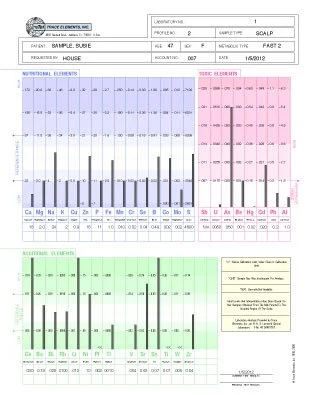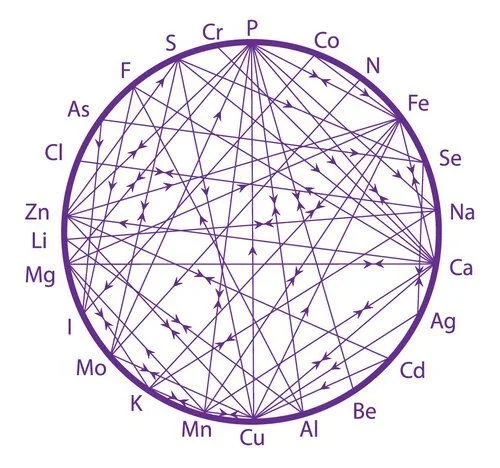HTMA 101: Hair Tissue Mineral Analysis Explained
Hair Tissue Mineral Analysis (HTMA) was developed several decades ago but has been gaining considerable attention by practitioners in the past years. And for good reason! It is incredibly useful for a vast number of individuals and conditions, including children and even pets. This article serves as a comprehensive introduction to HTMA, exploring its principles, benefits, and the valuable information it offers regarding our mineral status.
What is a Hair Tissue Mineral Analysis (HTMA)?
HTMA is a non-invasive functional lab test that involves the microscopic examination of a hair sample. Typically taken from the back of the head, this sample is analysed to determine the concentrations of various minerals, including both essential elements and potentially toxic metals. The measured mineral content of the hair reflects how much of these elements are in the tissues of the body.
What are the Benefits of a Hair Test Versus a Blood Test?
Well first of all, there are no needles implicated in the process. That’s a strong plus for children scared of needles and adults alike. Most importantly, the information we get from the hair test covers a longer window of time (the period it took to grow about 1 inch of hair) versus the data of the exact time on a given day when the blood is drawn (snapshot). This means that hair reflects a longer history of mineral and toxin exposure compared to blood. A hair sample can provide insights into nutrient levels and potential imbalances over a more extended period, typically covering several weeks to months. In comparison, blood tests offer a snapshot at the time of the test, providing immediate information but a shorter-term perspective. There’s also the implication that blood aims to keep homeostasis at all times, so it doesn’t reflect the actual mineral and nutrient levels in the tissues after all.
Of course, hair tests and blood tests serve different purposes and offer distinct advantages depending on the information you're seeking. In other words, blood testing and hair testing give us very complementing data which I like to assess in tandem. They both have their strengths and provide valuable and scientific information.
The Process of Hair Analysis
The hair sample undergoes a precise analysis in a laboratory, providing a detailed report of mineral patterns within the body. A trained healthcare professionals or skilled practitioner (such as myself ) is needed to interpret the results. Here is an example of the first page of the report:
Key Minerals Assessed
Minerals are the spark plug of life. They are required for just about every metabolic process in the body. Every single enzymatic reaction relies on them. They play a crucial role in emotional regulation, promoting restful sleep, facilitating digestion, energy production, thyroid health, balancing hormones, supporting immune function, aiding detoxification, enabling nerve and muscle function, regulating pH balance, warding off allergies, preventing inflammation, supporting the health of our bones and teeth, managing weight, and much more!
HTMA assesses essential many minerals vital for health, such as magnesium, calcium, potassium, sodium and zinc, as well as many useful trace minerals and harmful heavy metals like lead, mercury, aluminium and cadmium.
Benefits of HTMA
HTMA offers a holistic understanding of mineral patterns, providing insights into nutritional status and potential deficiencies. It can identify imbalances before they manifest as symptoms, enabling early intervention and proactive health management. It also identifies potentially harmful levels of toxic metals, offering guidance on detoxification strategies. HTMA results guide highly personalised nutrition and supplement plans tailored to an individual's unique needs.
HTMA Ratios
Minerals assessed on their own do not give us much information. Instead, it is their relation to other elements (antagonist or agonist/synergist) and the ratio in which they are present that really gives us immense information. Appropriate mineral interactions are extremely complex with one another as well as with vitamins and other nutrients. Some of these interactions are shown in the Mineral Wheel below:
Mineral Wheel
by Dr. William Albrecht
The direction of the arrows denotes interactions.
Arrows aimed at each other denote mineral synergy (a complementing, supportive relation).
Arrows aimed away from each other denote mutual antagonism (a blocking, opponent force).
Now obviously this can look quite complex but that’s why you’ve got me! Keep reading :)
Here's an overview of some key ratios analysed in HTMA and the information they can offer:
Oxidation Rate
The ratio of certain minerals like phosphorous (P) and calcium (Ca) is analysed to determine an individual's oxidation rate. This information can provide insights into the body's ability to neutralise free radicals and manage oxidative stress. This is the primary ratio one must look at to determine if an individual is a slow or fast oxidizer. Calcium is a sedating minerals whereas phosphorus is stimulating.
Thyroid Ratio
The thyroid ratio in HTMA typically involves assessing the balance between minerals like calcium (Ca) and potassium (K). An imbalanced ratio may indicate potential issues with thyroid function. For instance, a calcium-to-potassium ratio that deviates from the norm might suggest hypothyroidism or hyperthyroidism.
Adrenal Function Ratios
Ratios involving sodium (Na) and Magnesium (Mg) as well as sodium (Na) and potassium (K) are often examined to assess adrenal function. Sodium and magnesium/potassium imbalances provide indications of adrenal fatigue and stress. For instance, elevated sodium-to-magnesium as well as elevated sodium-to-potassium ratios suggest acute stress and adrenal overdrive.
Hormonal & Digestive Ratio
Various mineral ratios in HTMA can offer insights into hormonal and digestive health. For example, imbalances involving zinc (Zn) and copper (Cu) may be associated with hormonal and digestive disorders. Proper zinc-to-copper ratios are also crucial for digestive enzyme function, and deviations may indicate issues such as leaky gut or impaired nutrient absorption.
Metabolic Ratio
Ratios involving elements like magnesium (Mg) and calcium (Ca) can provide information about metabolic efficiency. An imbalance in these ratios might indicate issues with insulin sensitivity, blood sugar regulation, or metabolic rate.
Heavy Metal Exposure (Toxic Ratios)
HTMA is also used to assess exposure to toxic heavy metals such as lead, mercury, arsenic, aluminium, and cadmium. Elevated levels of these metals can have detrimental effects on various organ systems and contribute to chronic health conditions. Minerals and heavy metals also share similarities in their chemical structures, and due to these similarities, they can compete for binding sites and receptors within the body. This phenomenon is known as "competitive inhibition" or "competitive binding". Without getting too much into details, it is important to understand the competition of specific minerals and their related heavy metals in order to aid the body with the detoxification process. These specific ratios are named Toxic Ratios on the complete HTMA report.
It's important to note that interpreting HTMA results requires expertise, and the ratios are just one aspect of the analysis. I like to consider these ratios alongside an individual's overall health picture, symptoms and other diagnostic information to dress a complete holistic view of the situation.
Limitations and Considerations
HTMA results may be influenced by external factors such as hair dyes, anti-dandruff shampoos or environmental contaminants. It's crucial to consider recent chemical hair treatments, as they may impact the accuracy of results. It is recommended to wait at least 6 weeks for the hair to grow before sampling the hair if you happen to have used any of these.
HTMA results can inform dietary adjustments to optimize mineral balance and is well integrated into holistic health practices. Hair Tissue Mineral Analysis is a valuable diagnostic tool that provides unique insights into our body's mineral composition. While it's not a standalone diagnostic method, when interpreted by a qualified practitioner, HTMA can contribute valuable information for individuals seeking a more comprehensive understanding of their health.



